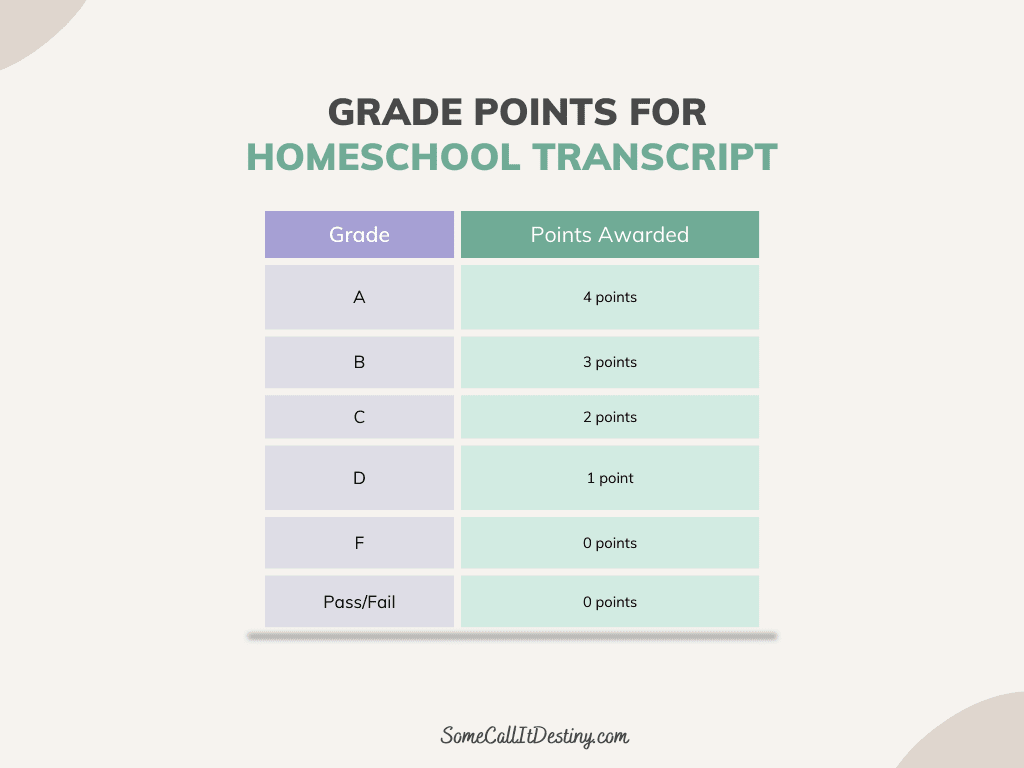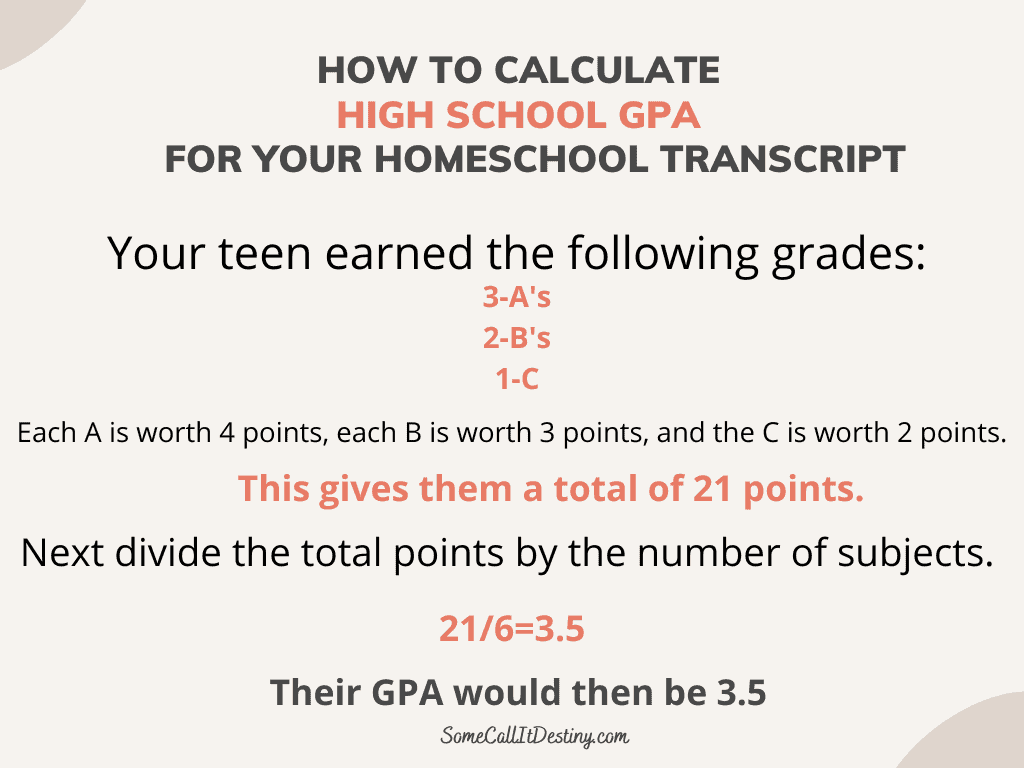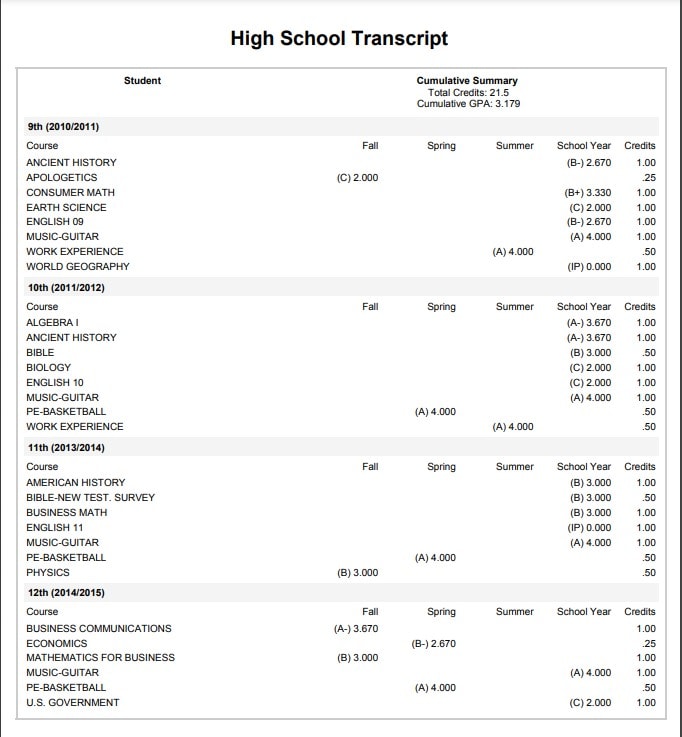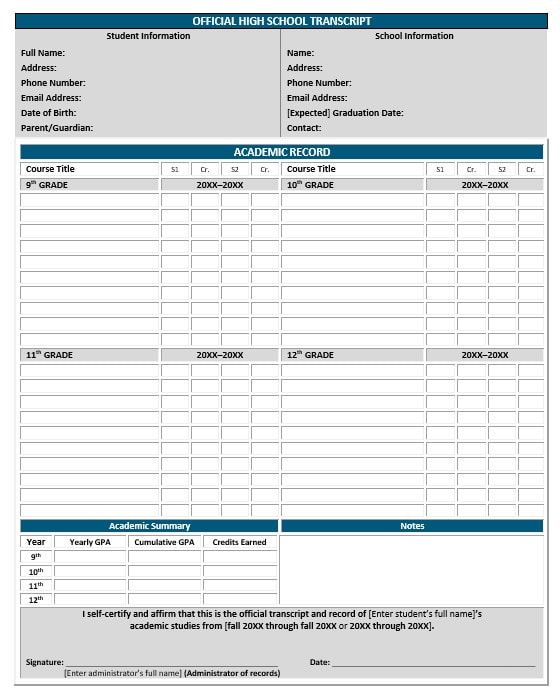Demystifying the Homeschool High School Transcript
The homeschool high school transcript. This one little document causes a lot of trouble and anxiety in the homeschool community. There’s an air of mystery surrounding the homeschool high school transcript that leaves many homeschoolers opting for public school to avoid what they see as a very complicated endeavor.
But the truth is, homeschool transcripts for high school are not that complicated. Truly. This isn’t a document you need to fear. It’s a simple matter of understanding exactly what you need–and don’t need–to create a high school transcript colleges want.
What is a Homeschool High School Transcript?
Let’s begin by going over exactly what a high school transcript is.
In short, it is a document that keeps track of:
- classes taken by your high school student
- the year they took the class
- the grade they received
- their cumulative GPA
- number of credits earned

This is the document colleges will ask for–not a diploma. A homeschool transcript is different from a homeschool diploma and colleges will never ask for a copy of the diploma.
Don’t Delay, Begin Today
When it comes to creating a homeschool transcript for your teen, the best advice is to do it as you go. Don’t wait until their senior year (or later!) to begin putting one together. I’ve seen parents who procrastinated or simply didn’t do one at all panicking because suddenly, years later, their child needs a copy of their transcript and they never put one together. Trying to remember what classes your child took, when, and what grade they received years later is a difficult task.
Save yourself the headache and begin their high school transcript when they begin taking high school classes.
I like to update my teen’s transcripts after every semester since some classes are only a semester long.
Related| Why You Need a Four-Year Plan to Homeschool High School
Homeschool High School Transcript: Year Vs. Subject
When putting together a transcript for your homeschooled high schooler you may hear of two different types of transcripts. The first is a traditional transcript that lists courses by the school year the student took them.
The other lists courses by subject. For example, grouping all the English classes together.
In my experience, colleges prefer a traditional transcript with courses listed by year. The first transcript I created I did by subject and had colleges come back and ask my daughter for a traditional transcript listed by year.
For that reason, I recommend creating a traditional transcript for your teen and that is the type I will go into detail about in this post.

Transcript Title and Personal Information
At the very top of your teen’s high school transcripts you will put:
Official High School Transcript
See that word “official?” It is a very important word. A small one, but when colleges ask for “official high school transcripts” for your child, they want to see the word. I actually had to re-send my oldest daughter’s transcript because I forgot the word “official” and the school asked for her to resubmit with her “official” transcript.
Some colleges may not care, but it’s such an easy add, that I recommend just including it.
After your official title, you will include personal information about your teen and their school. And yes, since they are homeschooled this information will be duplicated.
This should be in two columns.
The first column will have:
- Name of School–If you have a school name use it, or create one. It can be as simple as [last name] Homeschool.
- Address–Yes, this is your home address
- Phone number–This is your (the parent’s) number
- Admission date–This is the month and year your child began their freshman year
The second column will have:
- Name of student–Your child’s legal name-no nicknames
- Date of birth
- Address–Again, your home address
- Anticipated graduation date–the month and year they are expected to complete high school

What to Put On Your Homeschool Transcript
Now that you have the personal information taken care of, you are going to add the meat of the high school transcript. This is the information on classes and grades. I break mine up into seven columns:
- Basic Information
- Year
- Course Title
- Grade
- Credits Earned
- Grade Points
- GPA
Transcript–Basic Information
Under basic information, I list my grading scale. This tells whoever is looking at the transcript what rubric I used to assign the grades. My grading scale looks like this:
A-Superior (4)
B-Above Average (3)
C-Average (2)
D-Below Average (1)
P-Pass (0)
F-Fail (0)
In the parenthesis, I put the number of grade points awarded for each grade. Whatever grading scale you use should go here.
Next, I include a definition of my credit standard.
Credit Standard: One credit represents 180 hours of guided study per 36-week school year.
I also list any abbreviations I use and what they stand for. For example, my kids took a couple of classes at the local high school and some dual enrollment classes. These are included on their homeschool transcript with an abbreviation next to them in the course title indicating they were taken elsewhere. So under the Basic Information section, under Abbreviations, I would put SHS refers to classes taken at Skyline High School.
Next, you have the option of including an Awards/Achievements section here. This is different than their extracurricular resume (which they should also keep). Here you would list any outstanding awards or achievements your teen may have received that would influence admittance decisions. For example, if your teen received the Ronald Reagan Leadership Medal, you could list it here. Otherwise, you can leave this off.
Finally, the place for a certifying signature. And yes, this will be your signature.

Transcript–Year
This column is for the school year the classes were taken. I do not break mine down by semester, although you could if you wanted.
If your teen took high school classes as part of middle school, and you gave them high school credit, then they may have an extra year on their transcript. Likewise, if your teen is completing high school in five years instead of four.
Course Titles on Transcript
The next column is for your course titles. Course titles are not the same as course descriptions. Course descriptions would be a separate document.
Here’s an example of what your course titles might look like:
English I: Literature & Composition
Chemistry with Lab
Latin I
Advanced Women’s Choir
Course titles are best if they clearly indicate the course of study. Is it easily identified as English, Math, History, Elective, etc? Colleges like to be able to nicely match the admittance requirements with the classes on the high school transcript.
Awarding Grades for Your Homeschool Transcript
Even if you have never given grades before, don’t believe in them, whatever, in high school, for the purpose of a transcript, you need to award grades to your teen.
This can become tricky as many homeschoolers choose to work toward mastery or pursue delight-directed learning. Even this type of learning structure can be awarded grades.
Here are some other ways to determine how to award a grade that doesn’t depend on a percentage grade scale:

Awarding Pass/Fail Grades
You can also award a Pass/Fail grade for subjects. Pass/Fail should be used sparingly, you want more letter grades in order to determine GPA. But also because awarding a Pass doesn’t tell how well the teen knows the subject matter.
I would allow no more than one Pass/Fail class a year.
What are Credits or Units Earned in High School?
Every class your teen takes in high school will be worth 1 or .5 credits or units. Credits and units earned are different names for the same thing. One high school credit is typically the equivalent of 180 hours of course work or one year of study. A half credit is the equivalent of 90 hours or one semester of study.
All high school classes, regardless of difficulty are worth either 1 or .5 credits.
Dual enrollment classes are worth 1 or .5 high school credits–even if they are worth more college credits.
Typically, high school students are required to earn a specific number of credits in order to graduate. As the homeschool parent, you determine that number.
On the transcript, you record the number of credits.
Credits are not used in calculating GPA. Their purpose is to signify approximately how many hours of work the student spent on the class.
Using Grade Points to Determine GPA
The next thing to include on your homeschooler’s transcript is the number of grade points that were earned.
Some public high schools will weight GPA by awarding higher grade points. For example, 4 points for an A, but 5 points for an honors A. Not only does this make calculating GPA difficult, but colleges also don’t like weighted GPA’s. They will convert a weighted GPA to a regular GPA.
Save yourself time and frustration by using a straight grade point system.
For that you will give:

In the column next to the grade, you’ll list the number of points earned.
Calculating GPA on Your Homeschool Transcript
The last column on your teen’s homeschool transcript is for their GPA. I like to show a GPA tally at the end of each year.
To calculate GPA you will add up the number of grade points they have earned and then divide by the number of classes.
Pass/Fail classes are not included in your teen’s GPA, therefore you do not include them in the total number of classes you are dividing by. This number is only for classes awarded a letter grade.
Example of Calculating High School GPA for a Transcript:

GPA is cumulative. You include the previous year’s grades and grade points when you re-calculate GPA.
At the end of the section for each year I include the cumulative number of credits, grade points, and GPA.
Submitting a Homeschool Transcript to Colleges while Still in School
Homeschooled teens will begin applying and submitting their homeschool high school transcripts during their senior year. Before all classes have been completed and grades awarded.
Anytime your teen needs a copy of their transcript while they are currently completing classes, you will use IP, which stands for In Progress, in lieu of a grade.
Once the class is complete and the grade awarded, you will switch the IP for the letter grade.
Do I Need to Get My Homeschool Transcript Notarized?
No, you do not. Colleges recognize homeschool transcripts as legitimate. There is no reason to have it notarized. You are by default the administrator of records.
How Many Pages Should a High School Transcript Be?
All the information for your homeschool high school transcript should fit on one page.
Examples of Homeschool High School Transcripts
Now that you know what information needs to go on your homeschool teen’s transcript, the next step is creating the document to put it all. Here are a few different examples:
- You can create your own transcript. I use Word to create my homeschool transcript. Here is what mine looks like:

- If you have a membership to SchoolhouseTeachers.com, then you also get access to Applecore, which allows you to input your teen’s info and generates a transcript for you.

- HSLDA.org has a free homeschool high school transcript template you can use.

As you can see, there are a variety of ways to design a transcript for your homeschool teen. Just make sure the necessary information is included.
A Living Document
Your homeschooler’s high school transcript should be a living document until they graduate. It should be updated at least yearly. I suggest inputting the current classes at the beginning of each year and then adding the grades at the end.
You don’t need to dread the homeschool high school transcript. The key, really, is completing it as you go.







